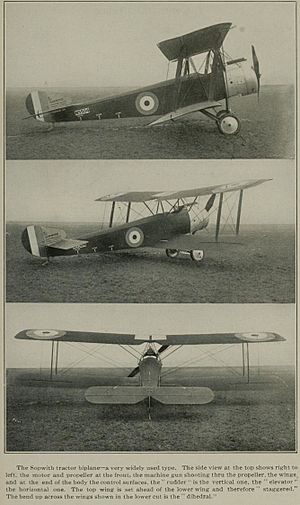Arthur Keen (RAF officer) facts for kids
Quick facts for kids
Arthur Willan Keen
|
|
|---|---|

Captain Keen at Bruay with 40 Squadron some time between April and November 1917
|
|
| Born | 20 March 1895 Edgbaston, Warwickshire, England |
| Died | 2 September 1918 (aged 23) Wimereux, France |
| Buried |
Terlincthun British Cemetery, Wimille, France
(50°44′41″N 1°36′37″E / 50.74472°N 1.61028°E) |
| Allegiance | United Kingdom |
| Service/ |
British Army Royal Air Force |
| Years of service | 1915–1918 |
| Rank | Major |
| Unit | Army Service Corps No. 70 Squadron RFC No. 40 Squadron RFC |
| Commands held | No. 40 Squadron RAF |
| Battles/wars | World War I • Western Front |
| Awards | Military Cross Bronze Medal of the Royal Humane Society |
Major Arthur Willan Keen was a brave British pilot during World War I. He was born on March 20, 1895, and sadly passed away on September 2, 1918. He became known as a "flying ace" because he shot down or helped shoot down 14 enemy aircraft.
Before he even fought in the air, Arthur showed great courage. In 1916, he saved another pilot from drowning. Because of his skills and bravery in combat, he quickly rose through the ranks. He became a major and led a squadron at just 23 years old.
Contents
Early Life and School
Arthur Keen was born in a place called Edgbaston in Warwickshire, England. His parents were Arthur Thomas Keen and Isabel Charlotte Eliza.
He went to several schools, including Aldro, Dunchurch Hall, and Rugby School. After that, in 1913, he went to Trinity College, Cambridge. There, he started studying engineering.
Joining the Military
Arthur left university after two years to join the Army. He became a temporary second lieutenant in the Royal Army Service Corps in May 1915.
In November 1915, he switched to the Royal Flying Corps. This was the air force before it became the Royal Air Force. He went to a special school to learn how to fly. On January 17, 1916, he earned his pilot's license. He learned to fly a type of plane called a Maurice Farman biplane. In February, he became a flying officer, and in June, he was promoted to lieutenant.
A Daring Rescue
On June 17, 1916, something amazing happened. Another pilot, Lieutenant Robert Edward Andrew MacBeth, crashed his plane into the sea. Arthur Keen saw the crash from his own plane. He quickly landed his aircraft nearby. Then, he bravely swam out to help MacBeth get back to shore. For this heroic act, he received the Bronze Medal of the Royal Humane Society. This award is given to people who save lives.
Combat in France
After his training, Arthur was sent to France with No. 70 Squadron RFC. He flew a plane called the Sopwith 1½ Strutter. On August 28, 1916, he got his first aerial victory. He forced a German Fokker D.II plane out of the sky over Bapaume.
In October 1916, he became a flight commander and was promoted to captain. He then returned to England to teach other pilots how to fly. He was an instructor from December 1916 to April 1917.
Leading a Squadron
In April 1917, Arthur joined No. 40 Squadron RFC. On May 1, flying a Nieuport 17, he destroyed a German Albatros D.III plane. This was his second victory. Between May and August 1917, he achieved ten more victories. The next day, he was awarded the Military Cross for his bravery.
After this, Arthur was taken out of combat for a rest. He worked as an instructor at the Central Flying School starting in November 1917.
On April 1, 1918, he was made an acting major. He was given command of a flying training squadron. But soon, he returned to France to lead No. 40 Squadron. This happened after their previous commander, Roderic Dallas, passed away.
While leading the squadron, Arthur flew an S.E.5a plane. He scored two more victories, one on June 30 and another on August 9. This brought his total number of victories to 14. He had set four German fighters on fire. He destroyed three others, sharing one of them. He also forced seven enemy aircraft down out of control.
Final Days
Sadly, Arthur was badly burned in a flying accident on August 15, 1918. The accident happened at Bruay, which was No. 40 Squadron's airfield. He passed away from his injuries on September 2, 1918. He was in a hospital in Wimereux, France. Arthur Willan Keen is buried in the Terlincthun British Cemetery in Wimille, France.
Awards and Recognition
Arthur Willan Keen received several honors for his bravery and service.
Military Cross
He was awarded the Military Cross for his outstanding courage. The award citation said: "For conspicuous gallantry and devotion to duty. He has shown the greatest gallantry and skill in aerial fighting, and his daring in leading offensive patrols into favourable positions for attack has been the means of many hostile aircraft being destroyed and driven down."
This means he was very brave and skilled in air battles. He was also daring in leading his patrols. His leadership helped destroy or force down many enemy aircraft.
Bronze Medal of the Royal Humane Society
He received this medal for saving a fellow pilot from drowning in 1916.


